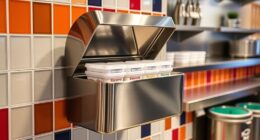An SOP in restaurants is a set of clear, step-by-step instructions that you follow to guarantee consistent quality, safety, and efficiency every day. It helps you maintain menu consistency, minimize errors, and promote safety during busy shifts. SOPs also streamline staff training and improve customer experiences by making operations smoother. If you keep going, you’ll discover how implementing SOPs can make your restaurant more professional and successful.
Key Takeaways
- SOPs in restaurants are detailed, written procedures that standardize daily operations and service quality.
- They ensure consistency in food preparation, presentation, and customer service across shifts and staff members.
- SOPs help train new employees efficiently and reduce errors during busy periods.
- They promote safety, hygiene, and operational efficiency by providing clear guidelines.
- Implementing SOPs supports a professional, cohesive work environment and enhances customer satisfaction.

Implementing Standard Operating Procedures (SOPs) in restaurants is essential to guarantee consistent quality, safety, and efficiency. When you establish clear SOPs, you create a foundation that ensures every dish served maintains the same high standard, which is vital for menu consistency. Customers expect familiar flavors and presentation each time they visit, and SOPs help you deliver just that. By documenting how each item should be prepared, plated, and presented, you minimize variations that can occur from individual differences or rushed staff. This consistency not only satisfies customers but also builds your restaurant’s reputation, encouraging repeat business.
Staff training plays a pivotal role in the success of SOP implementation. When you onboard new employees, providing extensive training based on your SOPs ensures they understand your standards from day one. This structured approach simplifies onboarding, reduces errors, and fosters confidence among your team members. Regular training sessions reinforce these procedures, keeping everyone updated on any changes and emphasizing the importance of adhering to established protocols. This ongoing education helps maintain uniformity across shifts, so whether a dish is prepared in the morning or late at night, it meets your restaurant’s standards.
Furthermore, SOPs streamline daily operations, making staff training more effective. When procedures are clearly outlined, new team members can quickly learn their responsibilities without confusion or guesswork. You reduce the risk of miscommunication, mistakes, or safety hazards, which can compromise both quality and safety standards. Well-trained staff are more efficient, capable of handling busy periods calmly and correctly, ensuring that service remains smooth and organized. This consistency in performance directly contributes to a positive customer experience, as guests receive the same high level of service every visit.
In addition, having defined SOPs for menu consistency and staff training allows you to identify gaps or inconsistencies quickly. When issues arise, you can refer back to your documented procedures to troubleshoot and address problems promptly. This proactive approach helps you maintain control over your restaurant’s operations, ensuring that quality standards are upheld and that your team is aligned in their responsibilities. Research in somatic therapy shows that body awareness can significantly improve emotional regulation and reduce anxiety, which can be analogous to how attentive staff training improves operational stability. Over time, SOPs become a valuable training resource and reference point, making your staff more confident and your operations more reliable.
Ultimately, implementing SOPs centered around menu consistency and staff training empowers you to run a cohesive, professional restaurant. It guarantees that every aspect of your operation functions harmoniously, delivering a memorable dining experience that keeps customers coming back. With clear procedures and ongoing training, you foster a culture of excellence that supports long-term success.
Frequently Asked Questions
How Often Should Restaurant SOPS Be Reviewed and Updated?
You should review your SOPs at least every six months to guarantee they stay current and effective. Regular SOP review frequency helps identify outdated procedures or new safety regulations. Implement SOP update procedures promptly when changes are needed, involving staff feedback and management approval. Keeping your SOPs up-to-date ensures consistency, safety, and compliance, which are essential for smooth restaurant operations and maintaining high standards for both staff and customers.
Who Is Responsible for Creating and Implementing SOPS?
You’re responsible for creating and implementing SOPs in your restaurant, often involving staff roles like managers and supervisors. Studies show that well-trained employees follow procedures 30% more effectively, highlighting the importance of clear training methods. You should collaborate with team members during development to ensure practicality, then train staff thoroughly. Regular updates keep SOPs relevant, and your leadership guarantees consistent adherence, ultimately boosting efficiency and customer satisfaction.
Are SOPS Customized for Different Restaurant Types?
Yes, you should customize SOPs for different restaurant types to guarantee standardization practices support your specific operations. Tailoring SOPs helps maintain menu consistency across shifts and locations, ensuring each team member follows the same procedures. By adapting SOPs to your restaurant’s unique needs, you improve efficiency, reduce errors, and deliver a consistent customer experience, which ultimately enhances your brand’s reputation and customer satisfaction.
How Can Staff Be Effectively Trained on SOPS?
You can keep staff engaged and guarantee they master SOPs through interactive training methods like hands-on practice, role-playing, and quizzes. Start with clear demonstrations, then encourage questions and feedback to build confidence. Regular refreshers and real-life scenarios help reinforce learning. When staff actively participate, they’re more likely to remember and follow procedures accurately, turning routine training into an engaging experience that boosts overall restaurant efficiency.
What Tools or Software Can Help Manage Restaurant SOPS?
You can use digital tools like Trello, Asana, or Google Drive to manage restaurant SOPs effectively. These platforms allow you to organize, update, and share SOPs seamlessly. Incorporate training programs within these tools by embedding videos, checklists, and quizzes to guarantee staff understands procedures. Using these digital tools simplifies management and keeps your team aligned, making training more efficient and consistent across your restaurant.
Conclusion
Think of an SOP in restaurants as the compass guiding your team through a busy night. It keeps everyone on the same page, ensuring smooth sailing even when the rush hits. Without it, chaos can quickly take over, like a ship lost in stormy seas. But with clear procedures in place, you create a steady course toward success, where every dish served and every guest leaves happy. Embrace SOPs—they’re your map to a well-run, thriving restaurant.









